2013 NISSAN SENTRA phone
[x] Cancel search: phonePage 261 of 372
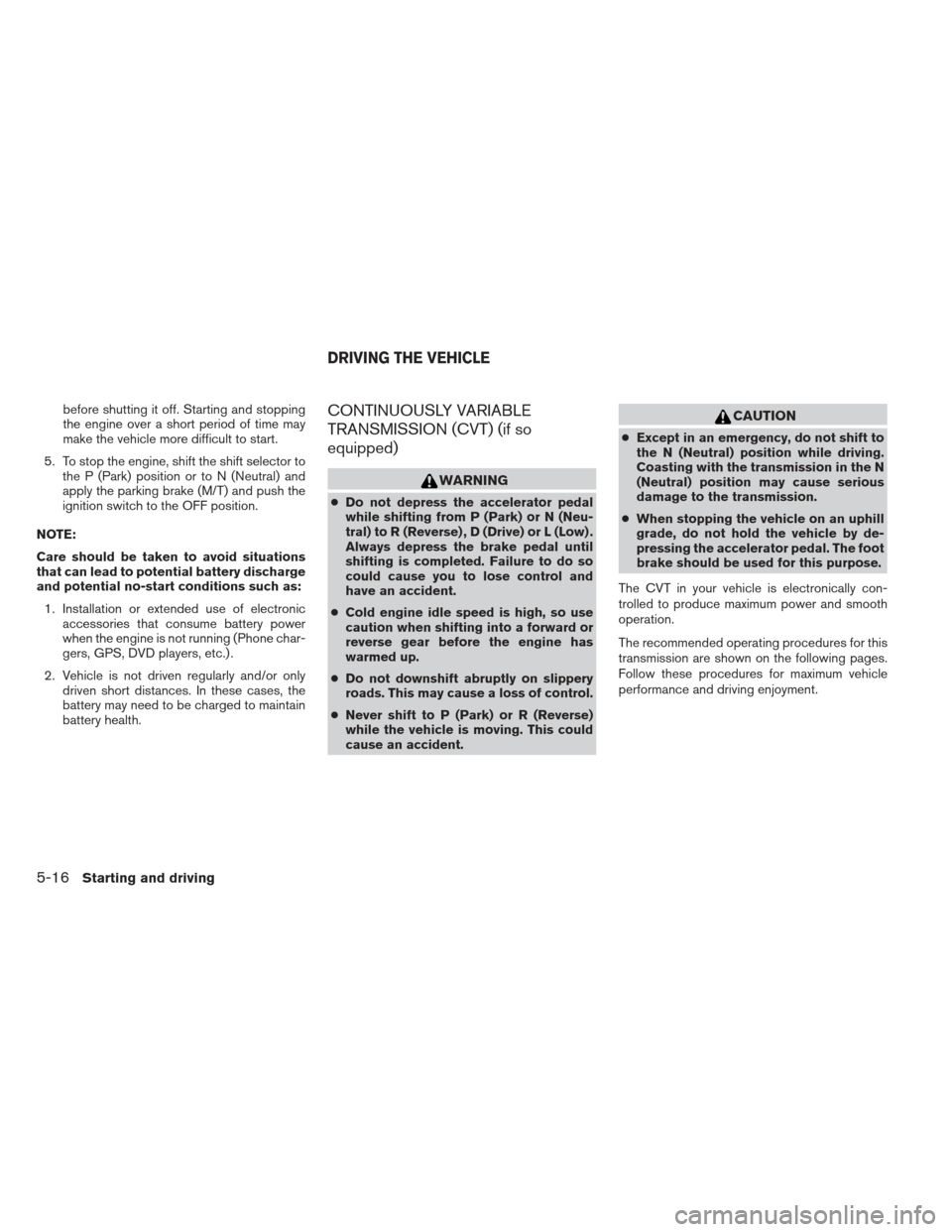
before shutting it off. Starting and stopping
the engine over a short period of time may
make the vehicle more difficult to start.
5. To stop the engine, shift the shift selector to the P (Park) position or to N (Neutral) and
apply the parking brake (M/T) and push the
ignition switch to the OFF position.
NOTE:
Care should be taken to avoid situations
that can lead to potential battery discharge
and potential no-start conditions such as: 1. Installation or extended use of electronic accessories that consume battery power
when the engine is not running (Phone char-
gers, GPS, DVD players, etc.) .
2. Vehicle is not driven regularly and/or only driven short distances. In these cases, the
battery may need to be charged to maintain
battery health.CONTINUOUSLY VARIABLE
TRANSMISSION (CVT) (if so
equipped)
WARNING
●Do not depress the accelerator pedal
while shifting from P (Park) or N (Neu-
tral) to R (Reverse) , D (Drive) or L (Low) .
Always depress the brake pedal until
shifting is completed. Failure to do so
could cause you to lose control and
have an accident.
● Cold engine idle speed is high, so use
caution when shifting into a forward or
reverse gear before the engine has
warmed up.
● Do not downshift abruptly on slippery
roads. This may cause a loss of control.
● Never shift to P (Park) or R (Reverse)
while the vehicle is moving. This could
cause an accident.
CAUTION
● Except in an emergency, do not shift to
the N (Neutral) position while driving.
Coasting with the transmission in the N
(Neutral) position may cause serious
damage to the transmission.
● When stopping the vehicle on an uphill
grade, do not hold the vehicle by de-
pressing the accelerator pedal. The foot
brake should be used for this purpose.
The CVT in your vehicle is electronically con-
trolled to produce maximum power and smooth
operation.
The recommended operating procedures for this
transmission are shown on the following pages.
Follow these procedures for maximum vehicle
performance and driving enjoyment.
DRIVING THE VEHICLE
5-16Starting and driving
Page 307 of 372
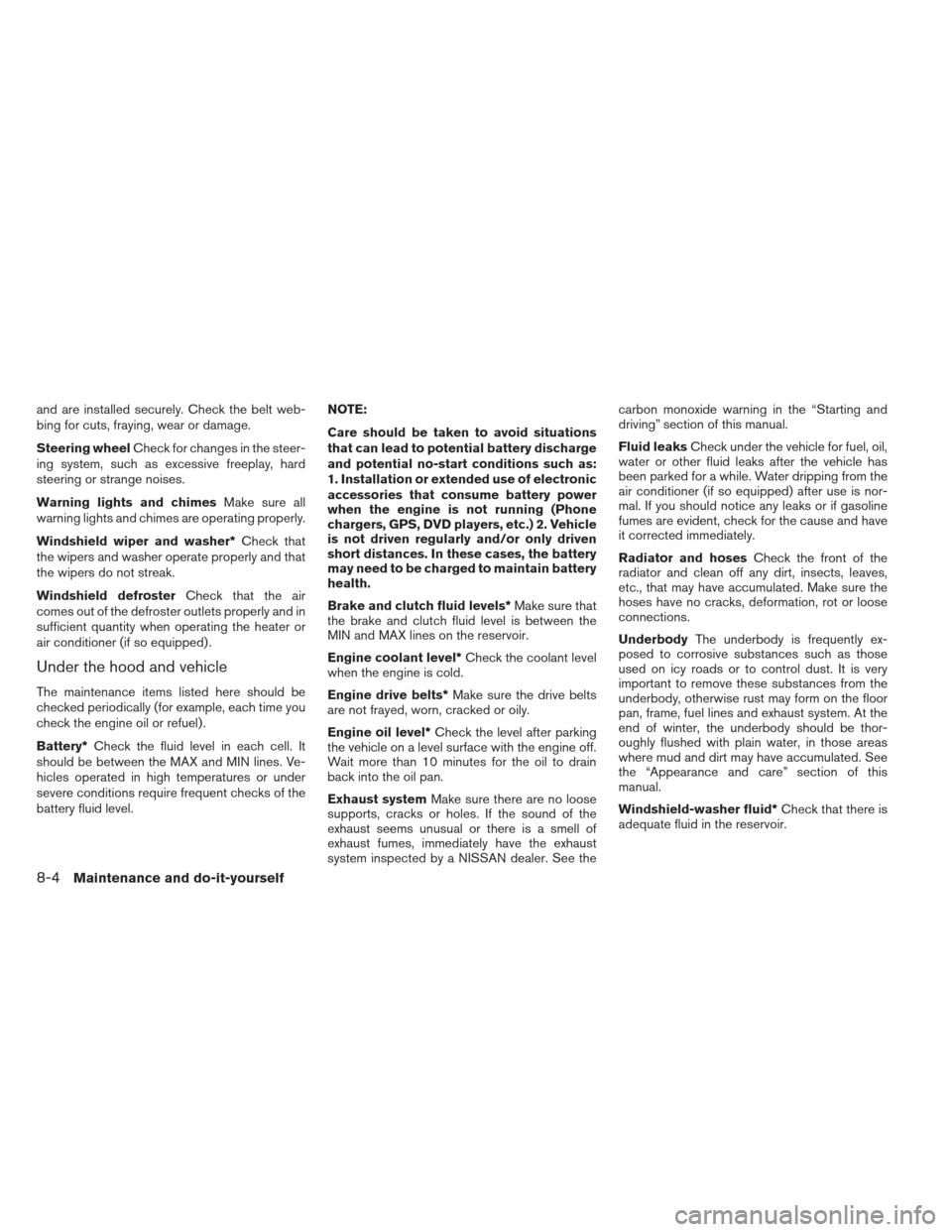
and are installed securely. Check the belt web-
bing for cuts, fraying, wear or damage.
Steering wheelCheck for changes in the steer-
ing system, such as excessive freeplay, hard
steering or strange noises.
Warning lights and chimes Make sure all
warning lights and chimes are operating properly.
Windshield wiper and washer* Check that
the wipers and washer operate properly and that
the wipers do not streak.
Windshield defroster Check that the air
comes out of the defroster outlets properly and in
sufficient quantity when operating the heater or
air conditioner (if so equipped) .
Under the hood and vehicle
The maintenance items listed here should be
checked periodically (for example, each time you
check the engine oil or refuel) .
Battery* Check the fluid level in each cell. It
should be between the MAX and MIN lines. Ve-
hicles operated in high temperatures or under
severe conditions require frequent checks of the
battery fluid level. NOTE:
Care should be taken to avoid situations
that can lead to potential battery discharge
and potential no-start conditions such as:
1. Installation or extended use of electronic
accessories that consume battery power
when the engine is not running (Phone
chargers, GPS, DVD players, etc.) 2. Vehicle
is not driven regularly and/or only driven
short distances. In these cases, the battery
may need to be charged to maintain battery
health.
Brake and clutch fluid levels*
Make sure that
the brake and clutch fluid level is between the
MIN and MAX lines on the reservoir.
Engine coolant level* Check the coolant level
when the engine is cold.
Engine drive belts* Make sure the drive belts
are not frayed, worn, cracked or oily.
Engine oil level* Check the level after parking
the vehicle on a level surface with the engine off.
Wait more than 10 minutes for the oil to drain
back into the oil pan.
Exhaust system Make sure there are no loose
supports, cracks or holes. If the sound of the
exhaust seems unusual or there is a smell of
exhaust fumes, immediately have the exhaust
system inspected by a NISSAN dealer. See the carbon monoxide warning in the “Starting and
driving” section of this manual.
Fluid leaks
Check under the vehicle for fuel, oil,
water or other fluid leaks after the vehicle has
been parked for a while. Water dripping from the
air conditioner (if so equipped) after use is nor-
mal. If you should notice any leaks or if gasoline
fumes are evident, check for the cause and have
it corrected immediately.
Radiator and hoses Check the front of the
radiator and clean off any dirt, insects, leaves,
etc., that may have accumulated. Make sure the
hoses have no cracks, deformation, rot or loose
connections.
Underbody The underbody is frequently ex-
posed to corrosive substances such as those
used on icy roads or to control dust. It is very
important to remove these substances from the
underbody, otherwise rust may form on the floor
pan, frame, fuel lines and exhaust system. At the
end of winter, the underbody should be thor-
oughly flushed with plain water, in those areas
where mud and dirt may have accumulated. See
the “Appearance and care” section of this
manual.
Windshield-washer fluid* Check that there is
adequate fluid in the reservoir.
8-4Maintenance and do-it-yourself
Page 316 of 372
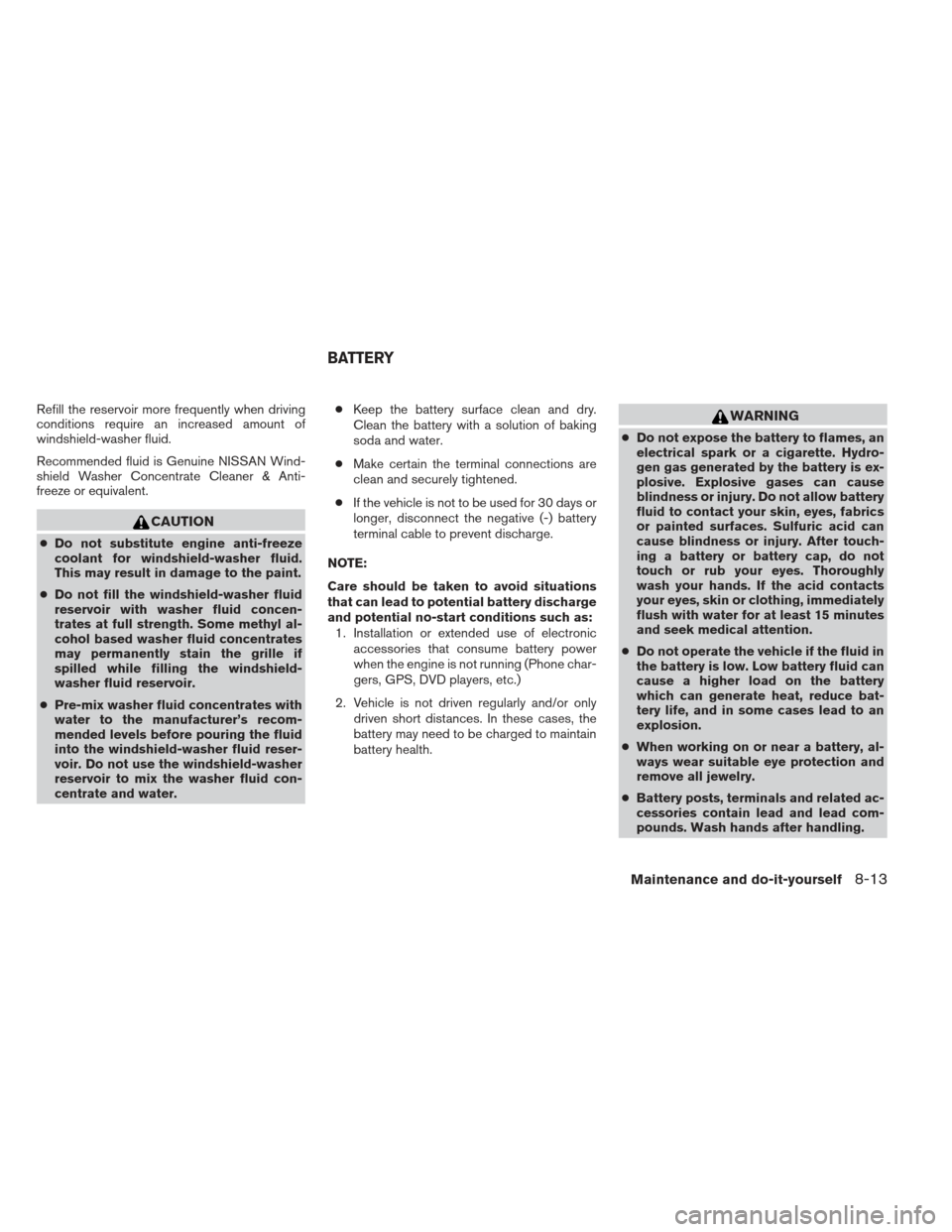
Refill the reservoir more frequently when driving
conditions require an increased amount of
windshield-washer fluid.
Recommended fluid is Genuine NISSAN Wind-
shield Washer Concentrate Cleaner & Anti-
freeze or equivalent.
CAUTION
●Do not substitute engine anti-freeze
coolant for windshield-washer fluid.
This may result in damage to the paint.
● Do not fill the windshield-washer fluid
reservoir with washer fluid concen-
trates at full strength. Some methyl al-
cohol based washer fluid concentrates
may permanently stain the grille if
spilled while filling the windshield-
washer fluid reservoir.
● Pre-mix washer fluid concentrates with
water to the manufacturer’s recom-
mended levels before pouring the fluid
into the windshield-washer fluid reser-
voir. Do not use the windshield-washer
reservoir to mix the washer fluid con-
centrate and water. ●
Keep the battery surface clean and dry.
Clean the battery with a solution of baking
soda and water.
● Make certain the terminal connections are
clean and securely tightened.
● If the vehicle is not to be used for 30 days or
longer, disconnect the negative (-) battery
terminal cable to prevent discharge.
NOTE:
Care should be taken to avoid situations
that can lead to potential battery discharge
and potential no-start conditions such as: 1. Installation or extended use of electronic accessories that consume battery power
when the engine is not running (Phone char-
gers, GPS, DVD players, etc.)
2. Vehicle is not driven regularly and/or only driven short distances. In these cases, the
battery may need to be charged to maintain
battery health.
WARNING
●Do not expose the battery to flames, an
electrical spark or a cigarette. Hydro-
gen gas generated by the battery is ex-
plosive. Explosive gases can cause
blindness or injury. Do not allow battery
fluid to contact your skin, eyes, fabrics
or painted surfaces. Sulfuric acid can
cause blindness or injury. After touch-
ing a battery or battery cap, do not
touch or rub your eyes. Thoroughly
wash your hands. If the acid contacts
your eyes, skin or clothing, immediately
flush with water for at least 15 minutes
and seek medical attention.
● Do not operate the vehicle if the fluid in
the battery is low. Low battery fluid can
cause a higher load on the battery
which can generate heat, reduce bat-
tery life, and in some cases lead to an
explosion.
● When working on or near a battery, al-
ways wear suitable eye protection and
remove all jewelry.
● Battery posts, terminals and related ac-
cessories contain lead and lead com-
pounds. Wash hands after handling.
BATTERY
Maintenance and do-it-yourself8-13
Page 363 of 372
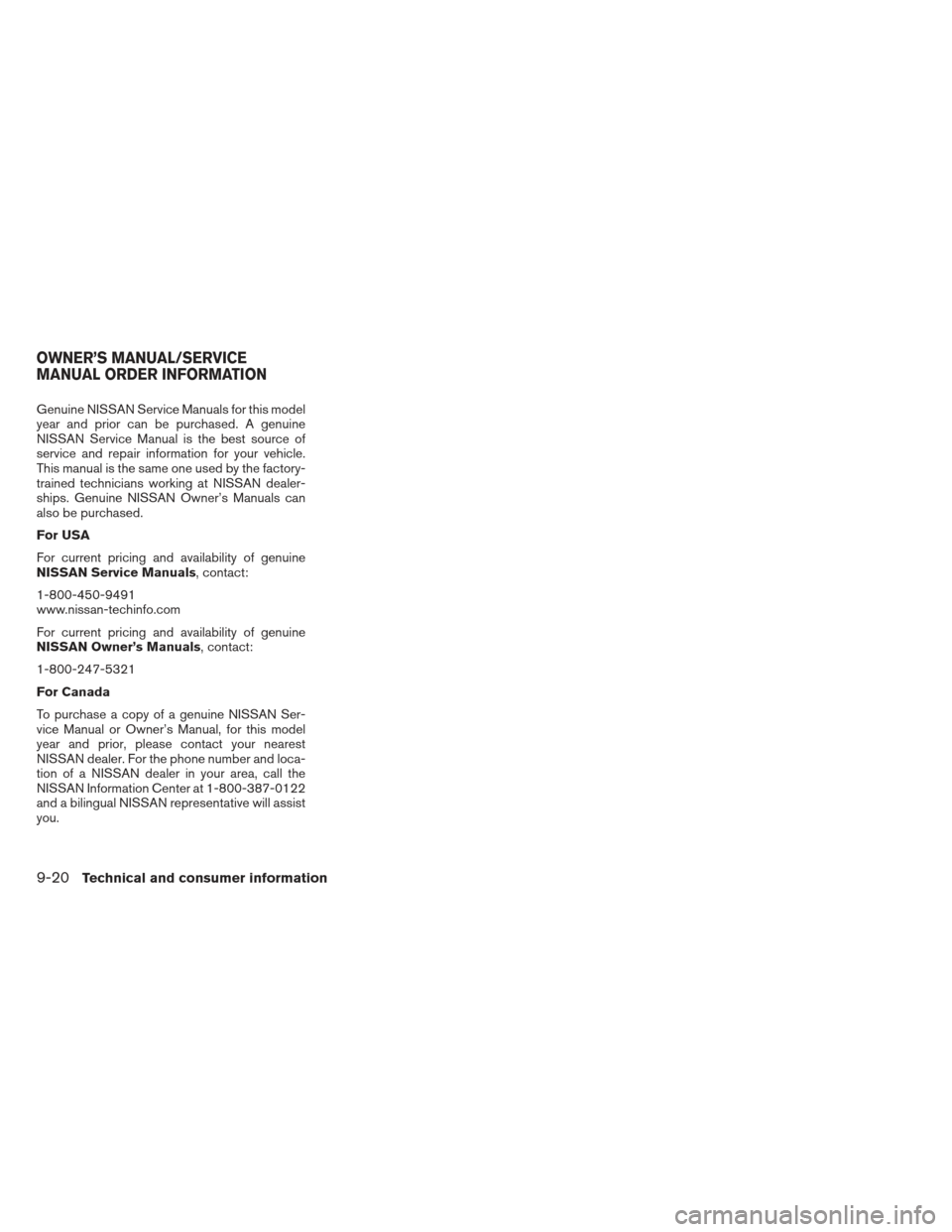
Genuine NISSAN Service Manuals for this model
year and prior can be purchased. A genuine
NISSAN Service Manual is the best source of
service and repair information for your vehicle.
This manual is the same one used by the factory-
trained technicians working at NISSAN dealer-
ships. Genuine NISSAN Owner’s Manuals can
also be purchased.
For USA
For current pricing and availability of genuine
NISSAN Service Manuals, contact:
1-800-450-9491
www.nissan-techinfo.com
For current pricing and availability of genuine
NISSAN Owner’s Manuals, contact:
1-800-247-5321
For Canada
To purchase a copy of a genuine NISSAN Ser-
vice Manual or Owner’s Manual, for this model
year and prior, please contact your nearest
NISSAN dealer. For the phone number and loca-
tion of a NISSAN dealer in your area, call the
NISSAN Information Center at 1-800-387-0122
and a bilingual NISSAN representative will assist
you.
OWNER’S MANUAL/SERVICE
MANUAL ORDER INFORMATION
9-20Technical and consumer information
Page 364 of 372
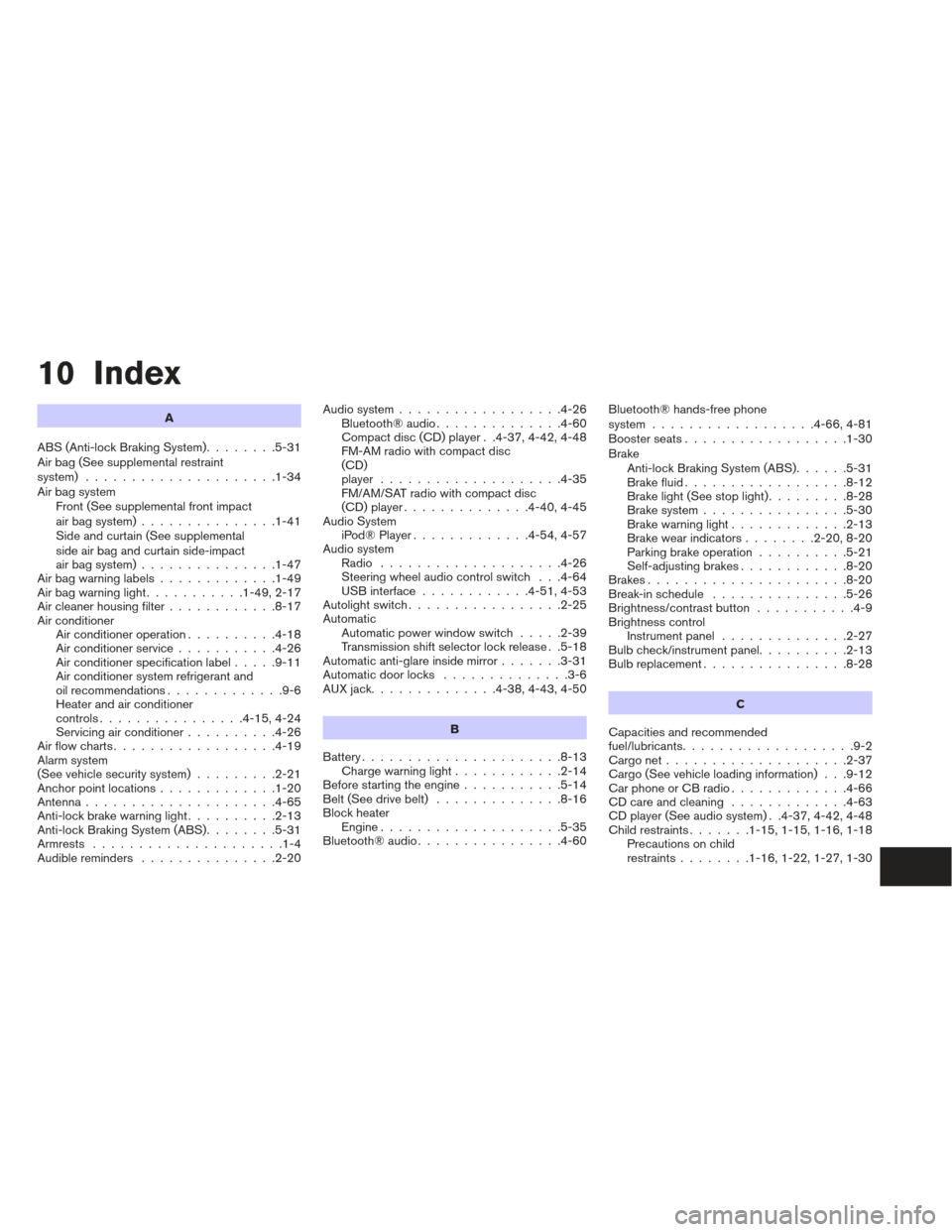
10 Index
A
ABS (Anti-lock Braking System) ........5-31
Air bag (See supplemental restraint
system) .....................1-34
Air bag system Front (See supplemental front impact
air bag system) ...............1-41
Side and curtain (See supplemental
side air bag and curtain side-impact
air bag system) ...............1-47
Airbagwarninglabels.............1-49
Airbagwarninglight...........1-49,2-17
Air cleaner housing filter ............8-17
Air conditioner Air conditioner operation ..........4-18
Air conditioner service ...........4-26
Air conditioner specification label .....9-11
Air conditioner system refrigerant and
oil recommendations .............9-6
Heater and air conditioner
controls................4-15,4-24
Servicing air conditioner ..........4-26
Airflowcharts..................4-19
Alarm system
(See vehicle security system) .........2-21
Anchor point locations .............1-20
Antenna.....................4-65
Anti-lock brake warning light ..........2-13
Anti-lock Braking System (ABS) ........5-31
Armrests .....................1-4
Audible reminders ...............2-20 Audio system
..................4-26
Bluetooth®audio..............4-60
Compact disc (CD) player . .4-37, 4-42, 4-48
FM-AM radio with compact disc
(CD)
player ....................4-35
FM/AM/SAT radio with compact disc
(CD) player ..............4-40,4-45
Audio System iPod®Player.............4-54,4-57
Audio system Radio ....................4-26
Steering wheel audio control switch . . .4-64
USB interface ............4-51,4-53
Autolight switch .................2-25
Automatic Automatic power window switch .....2-39
Transmission shift selector lock release . .5-18
Automatic anti-glare inside mirror .......3-31
Automatic door locks ..............3-6
AUXjack..............4-38,4-43,4-50
B
Battery ......................8-13
Chargewarninglight............2-14
Before starting the engine ...........5-14
Belt (See drive belt) ..............8-16
Block heater Engine ....................5-35
Bluetooth®audio................4-60 Bluetooth® hands-free phone
system
..................4-66,4-81
Boosterseats..................1-30
Brake Anti-lock Braking System (ABS) ......5-31
Brakefluid..................8-12
Brakelight(Seestoplight).........8-28
Brake system ................5-30
Brake warning light .............2-13
Brake wear indicators ........2-20,8-20
Parking brake operation ..........5-21
Self-adjusting brakes ............8-20
Brakes ......................8-20
Break-inschedule ...............5-26
Brightness/contrast button ...........4-9
Brightness control Instrument panel ..............2-27
Bulb check/instrument panel ..........2-13
Bulbreplacement................8-28
C
Capacities and recommended
fuel/lubricants ...................9-2
Cargonet....................2-37
Cargo (See vehicle loading information) . . .9-12
CarphoneorCBradio.............4-66
CDcareandcleaning .............4-63
CD player (See audio system) . .4-37, 4-42, 4-48
Child restraints .......1-15,1-15,1-16,1-18
Precautions on child
restraints ........1-16,1-22,1-27,1-30
Page 366 of 372
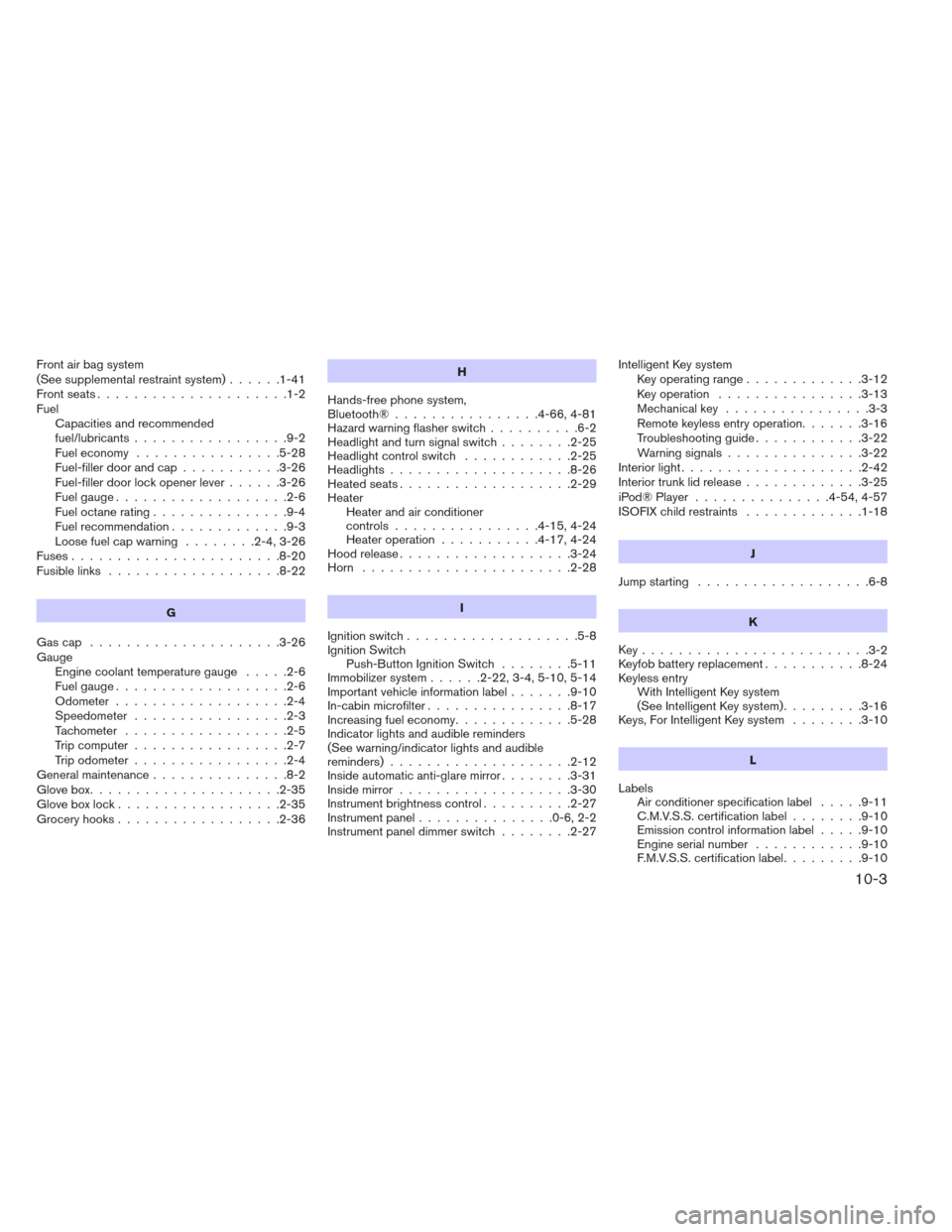
Front air bag system
(See supplemental restraint system)......1-41
Frontseats.....................1-2
Fuel Capacities and recommended
fuel/lubricants .................9-2
Fuel economy ................5-28
Fuel-filler door and cap ...........3-26
Fuel-filler door lock opener lever ......3-26
Fuel gauge ...................2-6
Fueloctanerating...............9-4
Fuel recommendation .............9-3
Loosefuelcapwarning ........2-4,3-26
Fuses.......................8-20
Fusiblelinks ...................8-22
G
Gascap .....................3-26
Gauge Engine coolant temperature gauge .....2-6
Fuel gauge ...................2-6
Odometer ...................2-4
Speedometer .................2-3
Tachometer ..................2-5
Trip computer .................2-7
Trip odometer .................2-4
Generalmaintenance...............8-2
Glovebox.....................2-35
Gloveboxlock..................2-35
Grocery hooks ..................2-36 H
Hands-free phone system,
Bluetooth®................4-66,4-81
Hazard warning flasher switch ..........6-2
Headlight and turn signal switch ........2-25
Headlight control switch ............2-25
Headlights ....................8-26
Heated seats ...................2-29
Heater Heater and air conditioner
controls................4-15,4-24
Heater operation ...........4-17,4-24
Hood release ...................3-24
Horn .......................2-28
I
Ignition switch ...................5-8
Ignition Switch Push-Button Ignition Switch ........5-11
Immobilizer system ......2-22,3-4,5-10,5-14
Important vehicle information label .......9-10
In-cabin microfilter ................8-17
Increasing fuel economy .............5-28
Indicator lights and audible reminders
(See warning/indicator lights and audible
reminders)....................2-12
Inside automatic anti-glare mirror ........3-31
Inside mirror ...................3-30
Instrument brightness control ..........2-27
Instrument panel ...............0-6,2-2
Instrument panel dimmer switch ........2-27Intelligent Key system
Key operating range .............3-12
Key operation ................3-13
Mechanical key ................3-3
Remote keyless entry operation.......3-16
Troubleshooting guide ............3-22
Warning signals ...............3-22
Interiorlight....................2-42
Interior trunk lid release .............3-25
iPod® Player ...............4-54,4-57
ISOFIX child restraints .............1-18
J
Jump starting ...................6-8
K
K
ey.........................3-2
Keyfob battery replacement ...........8-24
Keyless entry With Intelligent Key system
(See Intelligent Key system) .........3-16
Keys, For Intelligent Key system ........3-10
L
Labels Air conditioner specification label .....9-11
C.M.V.S.S. certification label ........9-10
Emission control information label .....9-10
Engine serial number ............9-10
F.M.V.S.S. certification label .........9-10
10-3
Page 368 of 372
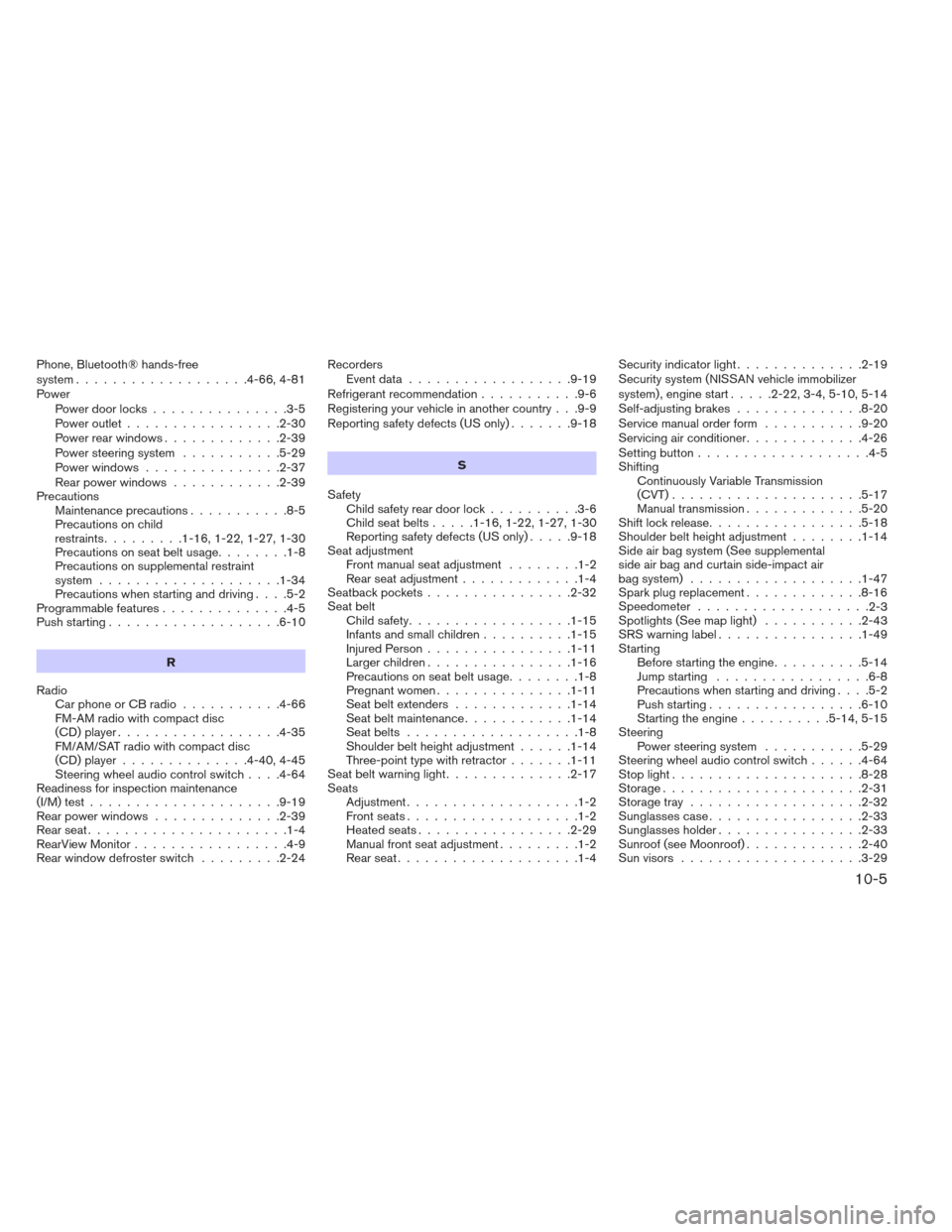
Phone, Bluetooth® hands-free
system...................4-66,4-81
PowerPower door locks ...............3-5
Power outlet .................2-30
Power rear windows .............2-39
Power steering system ...........5-29
Power windows ...............2-37
Rear power windows ............2-39
Precautions Maintenanceprecautions...........8-5
Precautions on child
restraints .........1-16,1-22,1-27,1-30
Precautionsonseatbeltusage........1-8
Precautions on supplemental restraint
system ....................1-34
Precautions when starting and driving ....5-2
Programmable features ..............4-5
Push starting ...................6-10
R
Radio Car phone or CB radio ...........4-66
FM-AM radio with compact disc
(CD) player ..................4-35
FM/AM/SAT radio with compact disc
(CD) player ..............4-40,4-45
Steering wheel audio control switch ....4-64
Readiness for inspection maintenance
(I/M) test .....................9-19
Rear power windows ..............2-39
Rearseat......................1-4
RearViewMonitor.................4-9
Rear window defroster switch .........2-24Recorders
Eventdata..................9-19
Refrigerant recommendation ...........9-6
Registering your vehicle in another country . . .9-9
Reporting safety defects (US only) .......9-18
S
Safety Child safety rear door lock ..........3-6
Child seat belts .....1-16,1-22,1-27,1-30
Reporting safety defects (US only) .....9-18
Seat adjustment Frontmanualseatadjustment ........1-2
Rear seat adjustment .............1-4
Seatback pockets ................2-32
Seat belt Childsafety..................1-15
Infants and small children ..........1-15
Injured Person ................1-11
Largerchildren................1-16
Precautions on seat belt usage ........1-8
Pregnant women ...............1-11
Seatbeltextenders .............1-14
Seatbeltmaintenance............1-14
Seatbelts ...................1-8
Shoulder belt height adjustment ......1-14
Three-point type with retractor .......1-11
Seat belt warning light ..............2-17
Seats Adjustment ...................1-2
Frontseats...................1-2
Heatedseats.................2-29
Manual front seat adjustment .........1-2
Rearseat....................1-4 Security indicator light
..............2-19
Security system (NISSAN vehicle immobilizer
system) , engine start .....2-22,3-4,5-10,5-14
Self-adjusting brakes ..............8-20
Service manual order form ...........9-20
Servicing air conditioner .............4-26
Setting button ...................4-5
Shifting Continuously Variable Transmission
(CVT).....................5-17
Manual transmission .............5-20
Shiftlockrelease.................5-18
Shoulder belt height adjustment ........1-14
Side air bag system (See supplemental
side air bag and curtain side-impact air
bag system) ...................1-47
Spark plug replacement .............8-16
Speedometer ...................
2-3
Spotlights(Seemaplight) ...........2-43
SRSwarninglabel................1-49
Starting Before starting the engine ..........5-14
Jump starting .................6-8
Precautions when starting and driving ....5-2
Push starting .................6-10
Starting the engine ..........5-14,5-15
Steering Power steering system ...........5-29
Steering wheel audio control switch ......4-64
Stoplight.....................8-28
Storage......................2-31
Storage tray ...................2-32
Sunglasses case .................2-33
Sunglasses holder ................2-33
Sunroof (see Moonroof) .............2-40
Sun visors ....................3-29
10-5